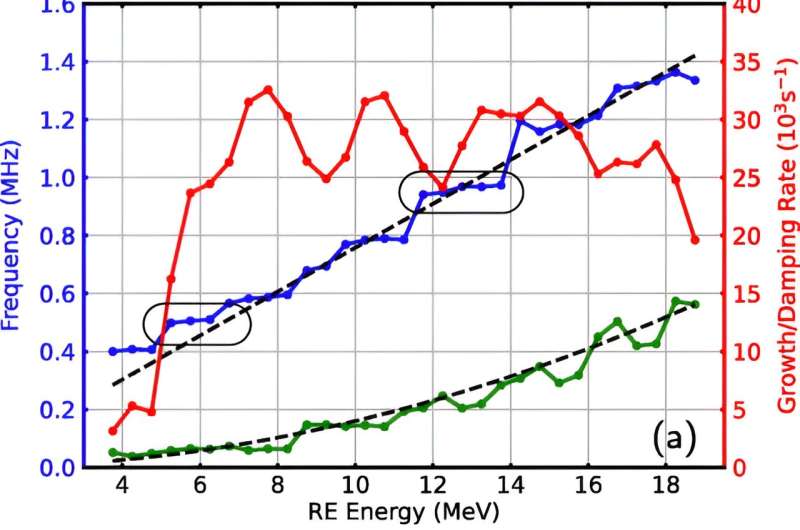This article has been reviewed according to Science X's editorial process and policies. Editors have highlighted the following attributes while ensuring the content's credibility:
fact-checked
peer-reviewed publication
trusted source
proofread
A breakthrough discovery could accelerate the arrival of controlled fusion energy on Earth

Researchers led by Chang Liu of PPPL have unveiled a promising approach to mitigating damaging runaway electrons created by disruptions in tokamak fusion devices. Key to the approach was harnessing a unique type of plasma wave that bears the name of astrophysicist Hannes Alfvén, a 1970 Nobel laureate.
Alfvén waves have long been known to loosen the confinement of high-energy particles in tokamak reactors, allowing some to escape and reducing the efficiency of the doughnut-shaped devices. However, the new findings by Chang Liu and researchers at General Atomics, Columbia University and PPPL uncovered beneficial results in the case of runaway electrons.
Remarkably circular
The scientists found that such loosening can diffuse or scatter high-energy electrons before they can grow into avalanches that damage tokamak components. This process was determined to be remarkably circular: The runaways create instabilities that give rise to Alfvén waves that keep the avalanche from forming.
"These discoveries provide a comprehensive explanation for the direct observation of Alfvén waves in disruption experiments," said Liu, a staff researcher at PPPL and lead author of a paper that details the results in Physical Review Letters. "The findings establish a distinct link between these modes and the generation of runaway electrons."
Researchers derived a theory for the remarkable circularity of these interactions. The results aligned well with runaways in experiments on the DIII-D National Fusion Facility, a DOE tokamak that General Atomics operates for the Office of Science. Tests of the theory also proved positive on the Summit supercomputer at Oak Ridge National Laboratory.
"Chang Liu's work shows that the runaway electron population size can be controlled by instabilities driven by the runaway electrons themselves," said Felix Parra Diaz, head of the Theory Department at PPPL. "His research is very exciting because it might lead to tokamak designs that naturally mitigate runaway electron damage through inherent instabilities."
Thermal quenches
Disruptions start with sharp drops in the million-degree temperatures required for fusion reactions. These drops, called "thermal quenches," release avalanches of runaways similar to earthquake-produced landslides. "Controlling disruptions stands as a paramount challenge to the success of tokamaks," Liu said.
Fusion reactions combine light elements in the form of plasma—the hot, charged state of matter composed of free electrons and atomic nuclei called ions—to release the vast energy that powers the sun and stars. Mitigating the risk of disruptions and runaway electrons would thus provide a singular benefit for tokamak facilities designed to reproduce the process.
Mitigating the risk of disruptions and runaway electrons would thus provide a singular benefit for tokamak facilities designed to reproduce the process.
The new approach could have implications for the advancement of ITER, the international tokamak under construction in France to demonstrate the practicality of fusion energy and could mark a key step in the development of fusion power plants.
"Our findings set the stage for creating fresh strategies to mitigate runaway electrons," Liu said. Now in the planning stage are experimental campaigns in which all three research centers aim to further develop the striking runaway findings.
More information: Chang Liu et al, Self-Consistent Simulation of the Excitation of Compressional Alfvén Eigenmodes and Runaway Electron Diffusion in Tokamak Disruptions, Physical Review Letters (2023). DOI: 10.1103/PhysRevLett.131.085102
Journal information: Physical Review Letters
Provided by Princeton Plasma Physics Laboratory





















